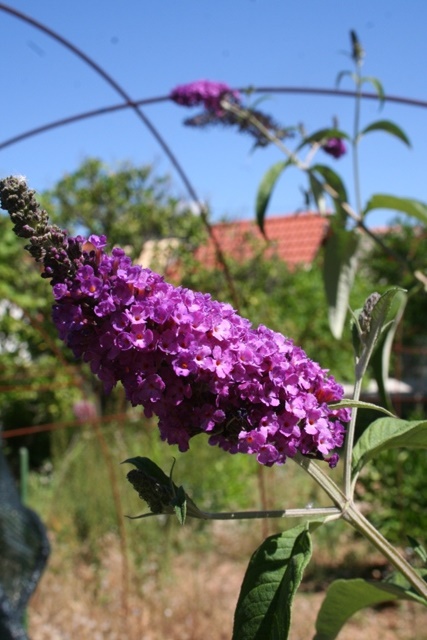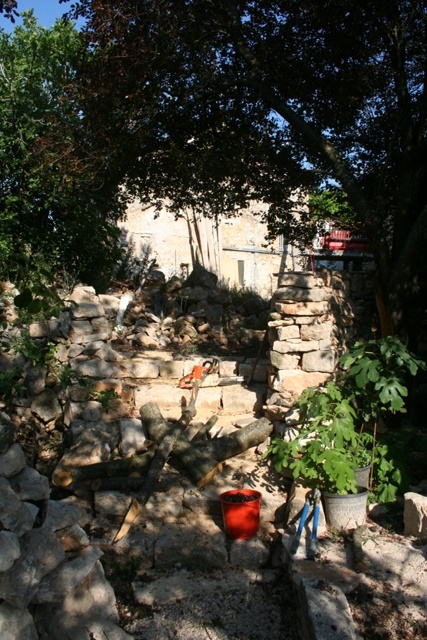Tarantula Lily

This week: Climate changing; Plants in bloom; Tarantula Lily; Weeds, weeds, weeds; Timber for the winter; ;
Out before 6am today, it was lovely in the orchards. Cool air flowing every so gently down the slope to the south of my home. Not a sound, not even a Cicada.
Then just after six, the sun started to illuminate the hillside above me, rapidly spreading down the tall, slender Italian Pencil Cypress, Cupressus sempervirens ‘Stricta‘. The early morning light deepening the pink flowers of the evergreen Nerium Oleander.
Soon everything was bathed in the warm sunlight as it climbed above the eastern hills. Another Mediterranean day was beginning…
Climate changing
This week has been another messed up week of weather. Not that I’m complaining though. Maximum temperatures have barely reached 30ºC, so down on the average. Starting work in the orchards before or around 06:00 the temperature has been 18ºC, so very pleasant.
But as different countries suffer heatwaves – over 20ºC in parts of Alaska, these temperature effects are not universal across continents.
With no rain, I am still irrigating daily. Running the underground system where I can, and watering by hand where the system has not yet been installed. Different plants are responding in different ways to these climatic changes.
I noticed this week that my Witch hazel, Hamamelis x intermedia Pallida, is flowering again. This is a plant which should flower in winter, before the leaves appear, but here it is in the middle of July putting out more fragrant flowers. I have three that are still in their small pots.

I plan to plant them out in the Autumn so that they can acclimatise over the winter and they will be in their final position, lining the path down into the top orchard, for next spring. It’s just too dry at the moment.
My design and planning has always been about thinking five to ten years ahead. How do I want the orchards to look, given they have a purpose too, when you walk round.
There is a saying about gardening in harsh, dry climates: You spend the first ten years persuading things to grow and the next twenty stopping them from growing!
What fruit trees do I want in the orchards – plant plums for your sons’ and pears for your heirs goes the old saying – knowing while they are establishing, I have a lot of building work to be getting on with.
Of course these saplings are not without maintenance, but it tends mostly to be winter time tasks. Note to self: Read up on summer pruning of cordon fruit trees….
Plants in bloom
Elsewhere another of the spring bloomers has flowers on it again.

This is Bachelors Button, Kerria Japonica, and as with the Witch-Hazel, it is flowering for a second time. They do look nice but I wonder if having moved them from their more northern temperate climate, this is their response. It will be interesting to see when and how often these plants come into bloom again next year .
On my patio I have a white Jasmine. Every time I pass it, the scent from the flowers assaults the senses. Although the flowers are fairly diminutive, they make up for it with the number and their smell.

I also have a number of giant Allium, Allium_giganteum, in flower. These are not the ones I bought as bulbs, but are the wild local variety, that have self seeded into the drupe orchard.

Some standing more than two meters tall, with a completely circular flower head, I am leaving them and will move the bulb once the flowers has died, so thet they are all in one place on the edge of the citrus orchard.

This is where my plans start to go astray. The eastern border of the citrus orchard backs onto my absentee neighbours unkempt plot. I have moved and re-planted some Lilac, Syringa Vulgaris, shrubs, to act as a wind and wind-borne weed seed break.
Looking at my original design, I was going to plant wild flowers in a meter wide strip along my side of the boundary, but although I have tried twice to seed with a wild flower and a pollinator mix, they never grew.
So I’m amending my plan to include the Alliums, which are local and seem to like the nutrient poor, dry, stony soil of the orchard.
I also went round and removed the dead flowers of the Buddleja this week, to encourage more flowers to form.

Tarantula Lily
I’ve got Dragons and Tarantulas in the garden!
If you are an arachnophobe, fear not, there are no eight legged, air breathing arthropods in this section.
I do have huge numbers of spiders, inside and outside, varying from the minute to the large but I regard them as friends and encourage them to trap all the annoying insects, especially mosquitoes, that they can.
One of the signature bulbs that I have in the garden is Hymenocallis, the Spider Lily. Hymenocallis Festalis. I have been growing them for a couple of years in pots, but although they flowered last summer, they were expanding beyond the confines of the pots, so I planted them out in the spring, before any shoots were showing.

It took me by surprise when I saw several flower buds appear a couple of weeks ago. This week several flower buds have burst.
They originate in the Americas and varieties are grown from the swamps and marshes of the south eastern Unites States to the dry grasslands of Peru.
Often just known by the common name – Spider Lily – they are also called Peruvian Daffodils.

I have been giving them water night and morning to improve the flowering, but once the showy heads have died back, I will ease off the irrigation.
Some varieties are considerably more spider like than others. Mine, with a large area of white membrane, reminds me of a Tarantula rather than one of your common-or-garden arachnids.
They have a delicate fragrance too, so are a real show stopper on the edge of the orchard.
There are other Tarantula plants, like Cleistocactus winteri the Tarantula Cactus.

There are also Tarantula ferns, and as I said I have at least one dragon in the garden too, although it is hibernating now for the summer…

Weeds, Weeds, Weeds
(To be sung to the 1976 melody by Sailor)
And just like the song they are Yellow; Red; Black and white;
Add a little bit of moonlight
Although even though we have had a full moon this week, I’ve not been weeding after dark. It has been a good week though to remove more weeds from the Drupe orchard. Perhaps the moonlight makes them easier to pull out.

In the central aisle it is a crop of Lucene, not a mass of weeds. I will cut it soon and reduce it to mulch.
I was told by a neighbour this week that I was cutting timber at the right time, during the phase when the moon is full, so maybe removing weeds at this point in the lunar cycle will prevent them growing again.
While removing weeds I did find a couple of nice grasses lurking in amongst the weeds. When I eventually dig out the ornamental pond, I want to use different grasses in groups around it.
Grasses tends to be the survivors of the wild and there are many different colours and types. Way back in January I wrote about some of my plans for grasses. I have several varieties growing in pots, producing seed and generally surviving, ready to be planted out in the final positions in due course.

Imagining and designing is fun, but it takes time for the grand design to actually happen.
With me it is because there are always so many other things which need doing. My intention was to have the ornamental pond dug out by now, but, well, you know how it is….
I am just keeping the area weed free for now!
Timber for the winter
I have picked more plums this week, at the same time I finished dismantling the damaged limb of the old Myrobalan plum.

I had to wait for the visitors who were staying in the next door guest house to leave because I needed to use the chain saw. In summer there are not supposed to be any noisy machines heard.
Once they had headed for the ferry, I started. Because the upper branches were resting in an apple tree and had a lot of plums on them, I didn’t want to just cut the broken limb off. Although more difficult, I dismantled the limb in small manageable pieces.

Working carefully at the top of the ladder with the chain saw, I cut the small branches, lowering them to the ground and then harvesting the plums.

It made me realise just how productive this tree is. There are still masses of plums in out- of-reach places and I think I have had some four buckets of fruit so far this year. The fruit at the top is feeding the birds, like this Golden Oriole, Oriolus oriolus.

Who resolutely refused to turn and be photographed properly. Butterflies and bees are feeding on lower fruit whilst plums on the ground are foot for all manner of insects and small mammals.
I gradually worked down the limbs until I didn’t need the ladder any more. This is a heavy dense wood so should burn well over the winter on the log fire.

At the end of the week, I cleared away the debris and I’ve started to work on my plans for next week. NRC
One Response
Marcy
You are an amazingly ambitious and productive person. Always amazed at all you get done in a week. Love those spider lilies. Saw them in Thailand and they were so beautiful. Have a great week and thanks for always sharing with me. Marcy